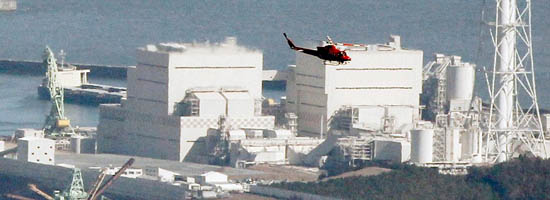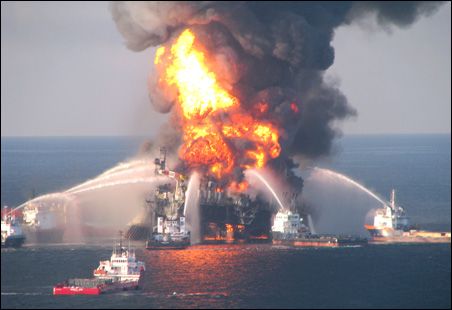How serious is the explosion at Japanese nuclear power plants?
Japanese nuclear safety officials assess damage at the Fukushima nuclear power plant after the 9.0-magnitude earthquake at level 4 on 7 levels, not as serious as the nuclear accident at Three Mile Island at USA in 1979, ranked level 5.

Fukushima No. 1 Nuclear Power Plant when a devastating explosion occurred
The International Atomic Energy Agency (IAEA) said it used the upper scale to communicate with the public in a consistent way about the safety of nuclear and X-ray events.
The IAEA scale, or INES, from level 1 to 7, with level 7 being the most serious, is considered a 'big crash' while level 1 is ' not normal '. The latter level is 10 times more serious than the previous level.
Chernobyl nuclear explosion in Ukraine in 1986, the worst nuclear power accident in history, ranked at level 7. That is the only case classified as a major accident in the history of nuclear power. The plant exploded due to uncontrollable skyrocketing energy that damaged the reactor core, causing radioactive clouds to spread across Europe.
'Chernobyl in the US'

Chernobyl in America
In the nuclear accident at Three Mile Island in Pennsylvania, the nuclear accident was dubbed ' Chernobyl in America', only a core of the reactor was melted. More specifically, the metal surrounding ceramic uranium pellets, containing most of the radioactivity and providing energy for the reactor, began to melt.
The reactors are operated at temperatures from 288 to 316 degrees C (550 to 600 degrees F). The metal above the fuel rods will not melt when the temperature has not exceeded 1,000 degrees Fahrenheit. The ceramic uranium pellets themselves will not melt when the temperature has not exceeded 2000 degrees F.
About half of the core of the Three Mile Island reactor melts before authorities recover enough cooling water to prevent the melting process. Other parts didn't suffer any damage and remained active to this day.
Earlier, the factory discharged some radioactivity to reduce the pressure, but experts said the radiation did not exceed the permissible level.
However, state authorities still require evacuation of pregnant women and school-aged children within a 5-mile radius (8km). Within a few days, 140,000 people left the area.
According to the US Nuclear Supervision Commission, the accident on Three Mile Island is caused by human error plus design errors and equipment failures.
After the incident, the Commission has tightened safety standards for US nuclear reactors, stopping construction of many in-construction reactors. The US nuclear power industry has not built new reactors in about 30 years and only a few years have passed since electrical companies have applied for more construction.
Despite being the worst nuclear accident in American history, no one was injured in the incident.
What happened at the Fukushima plant?
The explosion at the 40-year-old No. 1 Fukushima nuclear power plant occurred when the operator, Tokyo Electric Power Company (TEPCO), was trying to reduce the pressure from radioactive vapor emitted in the reactor core, after the power source To keep the cooling water circulating the reactor completely lost. The fuel rods in at least one reactor were damaged and partially melted, while the level of radioactivity was exceeded.
The plant was automatically shut down after an earthquake of 9.0 magnitude on Friday.
Soon after, an explosion broke out, causing the roof of a reactor broth to collapse. However, the government said the internal reactor container was not detonated.
But the Japanese government immediately requested the evacuation of tens of thousands of people living in a radius of 20km from the factory.
Currently, authorities at the factory are injecting seawater into at least two reactors to prevent the possibility that the core of the kilns will melt.
The cause and exact location of the explosion on Saturday now need to be explored, but ' so far it seems that the reactor core is not affected. This is still good news , 'said nuclear physics professor Paddy Regan of Surrey University.
The World Nuclear Association, based in London, thinks the explosion seems to be caused by a hydrogen explosion and may not have serious consequences.
' This is obviously a hydrogen explosion ,' said the Association's information director Ian Hore-Lacy. ' If hydrogen explodes, then it will run out and pose no further threat '.
- Explosion a third time at the Japanese nuclear power plant
- Explode again at the Japanese nuclear power plant
- Explosion lethal in the French nuclear power plant
- Potential threat from old nuclear plants
- Vietnam nuclear power needs to have standards
- Explosion at Japanese nuclear power plant
- Nuclear power against climate change
- Japan wants to erase nuclear power
- The weakness of the Japanese reactor cooling system
- There are signs of nuclear decay at Japanese power plants
- The first floating nuclear power plant will operate in 2016
- Iran-Russia agreed to build 2 more nuclear power plants
 Vietnam 5th Asian champion on fuel-efficient vehicles
Vietnam 5th Asian champion on fuel-efficient vehicles We can read all NASA studies completely free of charge
We can read all NASA studies completely free of charge Singer and songwriter Bob Dylan won the 2016 Nobel Prize for Literature
Singer and songwriter Bob Dylan won the 2016 Nobel Prize for Literature Scientific revolution in Asia
Scientific revolution in Asia